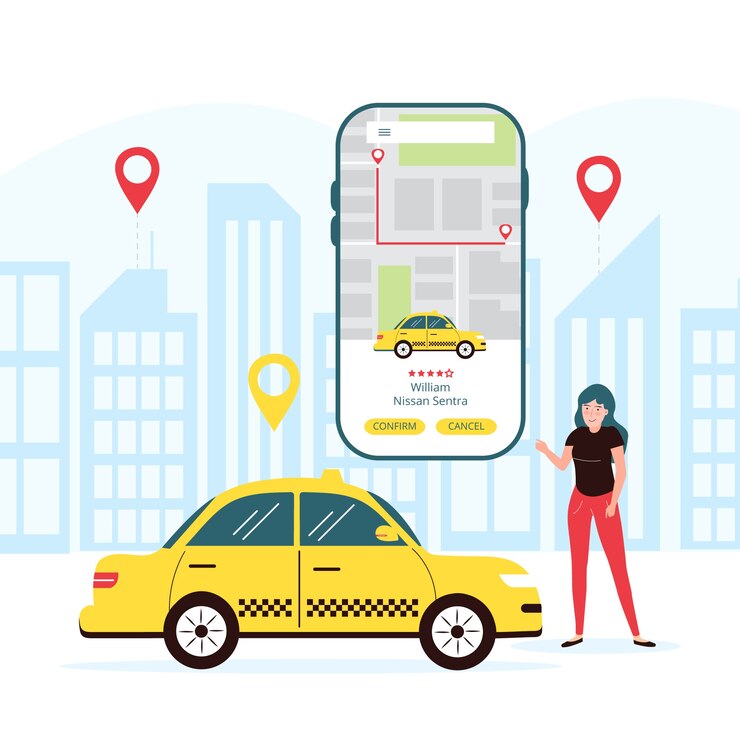In today’s competitive digital market, building a ride-sharing app that stands out requires a blend of innovative technology, user-friendly design, and a strong focus on user experience. With giants like Uber and Lyft dominating the space, creating a unique selling proposition for a new ride-sharing platform can be challenging. However, with a strategic approach that caters to users’ needs and differentiates your app from the competition, your app can achieve long-term success. Here’s a comprehensive guide to help you build a ride-sharing app.
Understanding the Core Features of a Successful Ride-Sharing App
To build a successful ride-sharing app, start by understanding the core features every platform should offer:
-
User Registration and Profile Creation: A seamless signup process through social media, email, or phone numbers is essential for user engagement. Allow users to create profiles where they can store their preferences, past rides, and payment information.
-
Real-Time GPS Tracking: Integrate GPS and real-time location services to enhance navigation and ensure drivers and riders can find each other easily. This feature improves safety and convenience, which are critical for a positive user experience.
-
Ride Booking and Scheduling: Allow users to book rides instantly or schedule them for later. An easy-to-use scheduling feature adds value for users who need reliable rides at specific times.
-
In-App Payments: Provide multiple payment options, including credit cards, digital wallets, and in-app wallets. Ensure secure payment gateways to foster trust.
-
Rating and Review System: This feedback loop between drivers and passengers enhances transparency and encourages better service.
By focusing on these essential features, you create a solid foundation that meets users’ expectations and builds trust.
Identifying Your Unique Selling Proposition (USP)
In a market crowded with ride-sharing apps, a distinct USP is vital to stand out. Here are a few strategies to consider:
-
Niche Targeting: Cater to specific user groups, such as rides for families, eco-friendly rides, or female-only drivers and passengers. Specialized services meet unique needs and can attract loyal users.
-
Safety Features: While safety is a baseline expectation, you can enhance it by integrating features like emergency buttons, live location sharing with trusted contacts, and driver background checks.
-
Value-Added Services: Offer premium options, like in-app entertainment, Wi-Fi, or vehicle choices such as electric or luxury cars. These add-ons create a more memorable ride experience.
-
Sustainable Options: With the growing emphasis on eco-friendly solutions, introducing an electric or hybrid car fleet appeals to environmentally conscious users.
Your USP should reflect what sets your ride-sharing app apart, whether it’s focused on a specific demographic, advanced safety measures, or sustainable practices.
Choosing the Right Technology Stack for Your Ride-Sharing App
The technology stack you select impacts your app’s functionality, scalability, and future maintenance. Here’s a look at the essential tech components:
-
Programming Languages: Use Swift or Objective-C for iOS and Kotlin or Java for Android development. These languages are well-suited for performance-driven, native apps.
-
Backend Development: Use frameworks like Node.js, Ruby on Rails, or Django to handle server requests, data management, and business logic. These frameworks are known for scalability and efficiency.
-
Database Management: For a large user base, opt for databases like MySQL, PostgreSQL, or MongoDB for flexible data storage.
-
Real-Time Features: Integrate APIs for live GPS tracking and push notifications. Google Maps API or Mapbox API provides accurate navigation, while Firebase enables real-time notifications.
-
Payment Integration: Stripe, PayPal, or Braintree APIs offer secure and reliable payment processing. Ensure compliance with security standards like PCI-DSS for financial transactions.
The right tech stack helps your app maintain stability and offers a seamless user experience, which is crucial for high user retention.
Developing a User-Friendly Design and Interface
An intuitive user interface (UI) and user experience (UX) design help your app attract and retain users. Here’s how to focus on effective design:
-
Simple Onboarding: The first interaction with your app should be smooth and informative. Use simple, direct language and visuals to guide users through setup without overwhelming them.
-
Clear Navigation: Use a clean layout and ensure that core functions (like ride booking and profile management) are easy to find. Group similar features together and maintain consistency across screens.
-
Efficient Booking Flow: Reduce the number of steps required for ride booking. Incorporate single-click options to set destinations and pick-ups and provide clear pricing upfront.
-
Accessibility: Ensure your app is accessible to everyone by incorporating voice commands, text-to-speech options, and scalable text size. This makes the app more inclusive and user-friendly.
By investing in a polished and accessible design, your app can appeal to a wider audience and provide a seamless, satisfying experience for all users.
Prioritizing Security and Privacy
Security and privacy are paramount in a ride-sharing app. Users expect data protection and personal safety at all times. Here are some strategies:
-
Data Encryption: Encrypt all sensitive information like payment details and personal data to prevent unauthorized access.
-
Secure Authentication: Implement two-factor authentication (2FA) and OTP verification for account access, ensuring users’ accounts are secure.
-
Background Checks: Conduct comprehensive background checks for drivers to enhance passenger safety and trust.
-
Privacy Policies: Clearly outline your data collection and usage practices in an accessible privacy policy. Ensure users understand how their data is managed and give them options to control it.
By prioritizing these security features, your app will foster trust and ensure compliance with data privacy laws.
Optimizing Performance and Scalability
To handle high demand and ensure fast load times, optimizing performance and scalability is essential:
-
Backend Scalability: Use cloud-based solutions like AWS, Google Cloud, or Microsoft Azure to easily scale your app as the user base grows.
-
Data Caching: Use caching mechanisms like Redis to store frequently accessed data, reducing server load and enhancing response times.
-
Efficient Code Structure: Regularly optimize and refactor your code to remove redundancies and improve processing speed.
-
Testing and Monitoring: Continuous performance monitoring and testing for issues help maintain optimal app performance.
Scaling your app as your user base grows ensures consistent, reliable service that meets user expectations.
Conclusion
Building a standout ride-sharing app requires a combination of core functionality, a unique selling proposition, and attention to user needs. From focusing on security and optimized performance to creating a user-friendly design, every decision plays a crucial role in crafting a successful app. As the ride-sharing industry continues to evolve, differentiating your app through niche targeting, innovation, and value-added features is key to capturing a loyal user base and maintaining a competitive edge.
FAQs
1. How long does it take to build a ride-sharing app?
Building a ride-sharing app can take 6-12 months, depending on complexity, features, and testing.
2. What is the approximate cost of developing a ride-sharing app?
The development cost for a ride-sharing app varies widely, generally ranging from $50,000 to over $200,000, depending on factors like region, features, and technology stack.
3. How can I ensure my app is safe for users?
Ensuring user safety involves implementing data encryption, secure authentication methods, and thorough driver background checks. Adding real-time location tracking and emergency features enhances passenger safety.
4. What are the top features of a successful ride-sharing app?
Top features include user registration, GPS tracking, ride booking, in-app payments, and rating systems. These features enhance functionality and user experience.
5. Can I create a niche ride-sharing app to compete with larger platforms?
Yes, targeting specific demographics, such as eco-conscious users or families, and offering unique features can help attract a loyal user base and differentiate your app from mainstream competitors.




